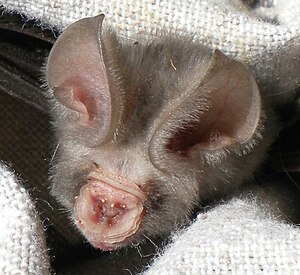Ordinary round nose
| Ordinary round nose | ||||||||||||
|---|---|---|---|---|---|---|---|---|---|---|---|---|

Common round-leaf nose ( Hipposideros caffer ) |
||||||||||||
| Systematics | ||||||||||||
|
||||||||||||
| Scientific name | ||||||||||||
| Hipposideros caffer | ||||||||||||
| ( Sundevall , 1846) |
The common round-leaf noses ( Hipposideros caffer ) is a bat from the family of the round-leaf noses (Hipposideridae), which is native to Africa.
The generic name Hipposideros is derived from the Greek "hippos" (= horse) and "sideros" (= iron) and refers to the horseshoe-shaped structure of the nasal blade . The species name caffer comes from that in South Africa living people of the Xhosa , which the Europeans earlier Kaffer called.
description
The common round nose is a medium-sized bat with a total length of 80 to 90 mm, a forearm length of 43 to 48 mm, a wingspan of around 200 mm and an average weight of 8 to 10 g. The females are slightly smaller (9.5 g) than the males (11 g). Like most horseshoe bats, the common round nose has a typical nasal structure consisting of two nasal blades that resemble a horseshoe . The shape of the nasal blades also distinguishes this species from other round-leaf noses . The coat color changes seasonally from gray to reddish gold-yellow, whereby young animals are more often colored gray than adult individuals. The partially sympathetic sister species Hipposideros ruber is usually larger (forearm length> 48 mm), has a reddish coat color and prefers wooded areas as a habitat compared to the savannah , in which the common round-leaf nose can be found.
Way of life
The common round-leaf nose is an agile flier, capable of short hovering flights, and like most bats is nocturnal. It occurs mainly in savannahs and specializes in moths ( Lepidoptera ). The prey is caught both in flight and from surfaces such as leaves. The bat is reliant on the prey flaps its wings, probably because they are in the echolocation doppler -verschobene information takes advantage to detect the prey. The average frequency of echolocation calls is 140 kHz and is therefore inaudible to the human ear. The echolocation calls are typically of higher frequency than those of Hipposideros ruber .
During the day, the species hangs in caves, mines, hollow trees, in house roofs and in attics. For night breaks, different hanging places are used than during the day. The group size can be up to 500,000 bats, depending on the hanging place, with the animals hanging close to one another, but mostly not touching. Other bat species such as the Egyptian slit nose ( Nycteris thebaica ), Coleura afra , Hipposideros ruber and Rhinolophus denti can often be found in the same daytime hanging places . The colonies are probably composed of several polygynous harems , which consist of a male with several females.
Among the known predators is the bat ( Macheirhamphus alcinus ). In addition to various ectoparasites , the endoparasite Trypanosoma leleupi , which is related to the pathogen that causes African sleeping sickness in humans, has also been detected for the common round-leaf nose . However, transmission to humans is not known and is unlikely.
Reproduction
The wearing time of the common round nose is 3.5–4 months depending on the region. In Nigeria , two months pass between mating and further development of the trophoblast , resulting in a total gestation time of 5 months. Females from populations in the northern hemisphere give birth to a young between March and April, while females in the southern hemisphere give birth to a young between October and November. Between 13 ° N and 15 ° S, the species is either bimodal polyestrial or can reproduce year-round. The young are born hairless and with their eyes closed. Immediately after birth, the females carry their young around with them in flight, but the young remain in the hanging place after a month at the latest while the females search for food. The young animals are suckled for a total of 3–3.5 months and begin their first attempts at flight from the age of one month.
distribution
The common round-leaf nose has a wide distribution area, from the western Arabian Peninsula over scattered areas south of the Sahara , with the exception of densely forested areas. In addition, the species occurs in southern Algeria , in central Niger , in eastern Chad , on the border between Senegal and Mauritania and on the coast of Morocco . The IUCN assesses the common round-leaf nose as safe thanks to its wide distribution, but points out the declining populations and taxonomic uncertainties.
literature
- GS Wright (2009): Hipposideros caffer. In: Mammalian Species . No. 845, pp. 1-9.

